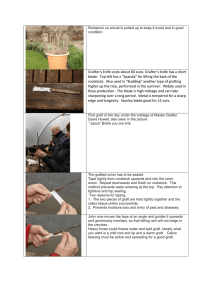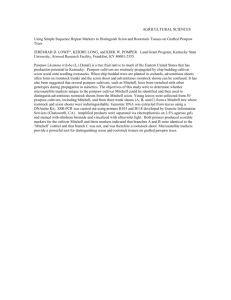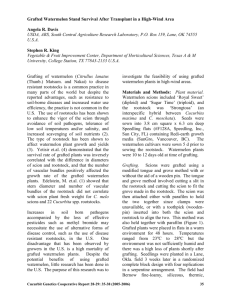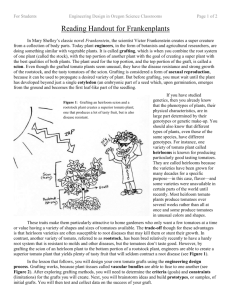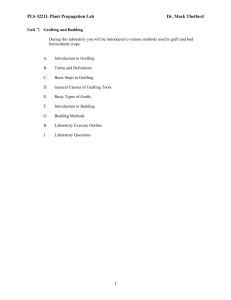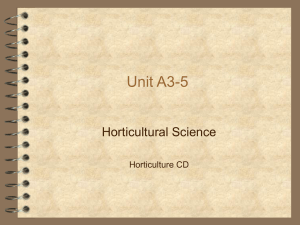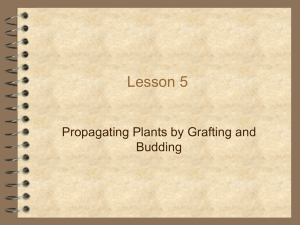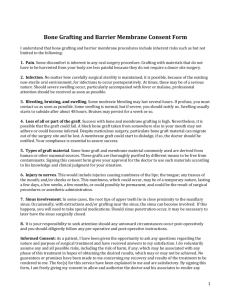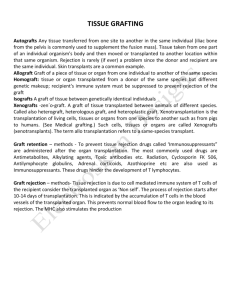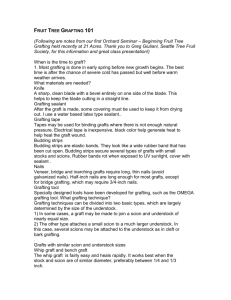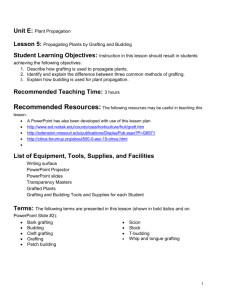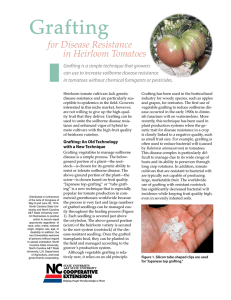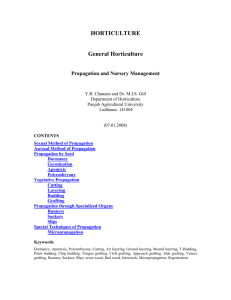Watermelon Grafting Methods Report 2008
advertisement
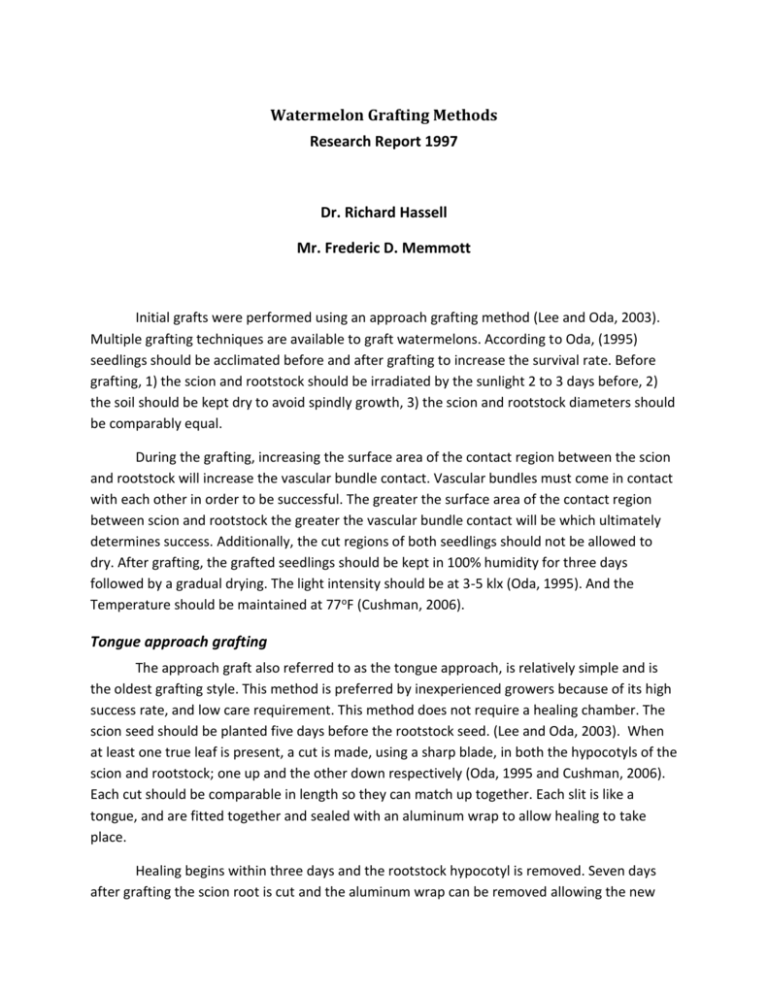
Watermelon Grafting Methods Research Report 1997 Dr. Richard Hassell Mr. Frederic D. Memmott Initial grafts were performed using an approach grafting method (Lee and Oda, 2003). Multiple grafting techniques are available to graft watermelons. According to Oda, (1995) seedlings should be acclimated before and after grafting to increase the survival rate. Before grafting, 1) the scion and rootstock should be irradiated by the sunlight 2 to 3 days before, 2) the soil should be kept dry to avoid spindly growth, 3) the scion and rootstock diameters should be comparably equal. During the grafting, increasing the surface area of the contact region between the scion and rootstock will increase the vascular bundle contact. Vascular bundles must come in contact with each other in order to be successful. The greater the surface area of the contact region between scion and rootstock the greater the vascular bundle contact will be which ultimately determines success. Additionally, the cut regions of both seedlings should not be allowed to dry. After grafting, the grafted seedlings should be kept in 100% humidity for three days followed by a gradual drying. The light intensity should be at 3-5 klx (Oda, 1995). And the Temperature should be maintained at 77oF (Cushman, 2006). Tongue approach grafting The approach graft also referred to as the tongue approach, is relatively simple and is the oldest grafting style. This method is preferred by inexperienced growers because of its high success rate, and low care requirement. This method does not require a healing chamber. The scion seed should be planted five days before the rootstock seed. (Lee and Oda, 2003). When at least one true leaf is present, a cut is made, using a sharp blade, in both the hypocotyls of the scion and rootstock; one up and the other down respectively (Oda, 1995 and Cushman, 2006). Each cut should be comparable in length so they can match up together. Each slit is like a tongue, and are fitted together and sealed with an aluminum wrap to allow healing to take place. Healing begins within three days and the rootstock hypocotyl is removed. Seven days after grafting the scion root is cut and the aluminum wrap can be removed allowing the new graft to depend solely on the new rootstock. (Oda, 1995). The advantages of using this graft is that it has a high survival rate, it’s simple, does not require low light and a high humidity environment for healing to take place, however there is substantial labor in returning throughout the healing process to cut the scion root, and remove the rootstock top (Cushman, 2006). Twice as much greenhouse spaces are needed for this type of graft. One cotyledon Graft The splice graft also known as: one cotyledon graft, and slant graft, is moderately simple and is perhaps the most popular among experienced growers and commercial nurseries. This graft is performed by hand, machine and robot (Lee and Oda, 2003). Plants are ready to graft when there is at least one true leaf on both the scion and the rootstock (Oda, 1995 and Cushman, 2006). The rootstock is carefully cut using a sharp blade at a diagonal to remove one cotyledon and the complete meristem. The angle should be close 45o degrees to have good surface area. The scion is cut at an opposite 45o angle approximately one inch below its cotyledons to facilitate clamping. The scion and rootstock are then joined together with a spring clam that is placed around the outside region of the splice. Following the grafting, the plants require shade, high humidity and temperatures around 77o F for three days. This method is less labor intensive requiring just a few tools, the removal of the clamp, and an increase of light and decrease of humidity after the third day to gradually begin normalizing them to the environment. Another advantage is that this graft produces strong and healthy seedlings since all vascular bundles of the rootstock are fused with the scion. Disadvantages are few and include a need for a good acclimating facility because poor environmental controls in humidity, light and temperature may cause high losses. Also the succors may return causing the graft to eventually abort if it is not completely removed. Side grafting The side graft is a modified whole insertion graft (Lee and Oda, 2003). The hole is made by using a sharp blade to cut a small slit through the rootstock hypocotyl instead of the top of the meristem. Grafting seedlings are ready to be grafted once there is at least on true leaf. The scion is then cut at an angle below the cotyledons and inserted into the slit which can be propped open with a toothpick. Place a clamp over the union to hold up the graft. Transfer the grafted seedlings into a humidity healing chamber, and maintain temperatures at 77 o F at low lighting for three days. The rootstock top should be removed after 5 days. This technique is very simple, but requires the removal of the top after the scion is healed. It also requires tight control of the humidity and temperature conditions to prevent high losses. Hole insertion or cut grafting (Oda 1995) The hole insertion graft is favored by some watermelon growers because of the smaller scion size compared to the rootstock. Watermelon seeds are sown a few days after the rootstock; days vary depending on the rootstock. Grafting begin 7-8 days after the watermelon seeds are sown, and requires at least one leaf on the scion and one small leaf on the rootstock. This being said, some growers insert very young scion seedlings (Lee and Oda, 2003). A specialized tool, such as a bamboo stick or small drill bit, is used to remove all of the meristem from the rootstock leaving a small hole with a small splice along both sides. The scion is then cut at a slant and placed within the hole. The grafted is then secured with a clamp and placed into a healing chamber with temperatures at 77o F, high humidity, and low light for three days. The disadvantage to the hole insertion graft is that it is much more technical and also requires careful control of the healing chamber. This technique is preferred by many commercial growers because it only requires the removal of the clamp after the healing has taken place. No additional planting or trimming is needed. One additional precaution is to not insert the seedling into the pith cavity of the rootstock. Adventitious roots from the scion may begin to elongate downward through the pith and into the soil which will void the resistance (Lee and Oda, 2003). Also the succors may return causing the graft to eventually abort if it is not completely removed. Hypocotyl Graft: This is the graft that we have been working on that has the most promise. The hypocotyl is completely severed just below the cotyledons. A silicone clip is placed near the soil surface on the hypocotyl. The hypocotyls is cut on a 35 to 45 degree angle as well as the scion material and then brought together, similar to the 0ne cotyledon graft. The clip is then slid over the grafted union and allowed to heal in the humid chamber for 7 to 10 days. Both the rootstock as well as the scion material has to be much older, 2 to 3 true leaves, in order for this to work. This method is still in the preliminary stages but holds a lot of promise. This method is very simple and produces no sigh of meristem re-growth of the root stock material. Further research is needed for this procedure to work properly.

